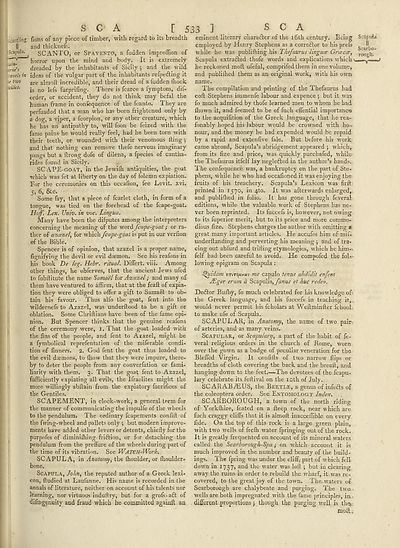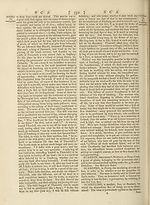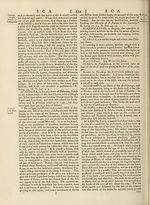Encyclopaedia Britannica, or, a Dictionary of arts, sciences, and miscellaneous literature : enlarged and improved. Illustrated with nearly six hundred engravings > Volume 18, RHI-SCR
(555) Page 533
Download files
Complete book:
Individual page:
Thumbnail gallery: Grid view | List view

s
jcantling fions of any piece of timber,
II and thicknefs.
Scapula. SCANTO, or SPAVENTO, a fadden impreffion of
horror upon the mind and body. It is extremely
dreaded by the inhabitants of Sicily s and the wild
■avelsin ideas of the vulgar part of the inhabitants refpe£ling it
e two are almoft incredible, and their dread of a fudden fnock
is no lefs furprifing. There is fcarce a fymptom, dif-
order, or accident, they do not think may befal the
human frame in confequence of the fcanto. They are
perfuaded that a man who has been frightened only by
a dog, a viper, a fcorpion, or any other creature, which
he has an antipathy to, will foon be feized with the
fame pains he would really feel, had he been torn with
their teeth, or wounded with their venomous fling •,
and that nothing can remove thefe nervous imaginary
pangs but a ftrong dofe of dilena, a fpecies of cantha-
rides found in Sicily.
SCAPE-goat, in the Jewilh antiquities, the goat
which was fet at liberty on the day of i'olemn expiation.
For the ceremonies on this occafion, fee Levit. xvi.
5, 6, &c.
Some fay, that a piece of fcarlet cloth, in form of a
tongue, was tied on the forehead of the feape-goat.
Hoff'. Lex. Univ. in voc. Lingua.
Many have been the difputes among the interpreters
concerning the meaning of the w ox difcape-go at ; or ra¬
ther of a%a%el. for which fcape-goat is put in our verfion
ef the Bible.
Spencer is of opinion, that azazel is a proper name,
fignifying the devil or evil daemon. See his reafons in
his book De leg. Hebr. ritual. Differt. viii. Among
other things, he obferves, that the ancient Jews ufed
to fubftitute the name Samuel for Aza-zel; and many of
them have ventured to dffirm, that at the feaft of expia¬
tion they were obliged to offer a gift to Samael to ob¬
tain his favour. Thus alfo the goat, fent into the
wildernefs to Azazel, was underftood to be a gift or
oblation. Some Chriftians have been of the fame opi¬
nion. But Spencer thinks that the genuine reafons
of the ceremony were, 1. That the goat loaded with
the fins of the people, and fent to Azazel, might be
a fymbolical reprefentation of the miferable condi¬
tion of finners. 2. God fent the goat thus loaded to
the evil daemons, to (how that they were impure, there¬
by to deter the people from any converfation or fami¬
liarity with them. 3. That the goat fent to Azazel,
fufficiently expiating all evils, the Ifraelites might the
more willingly abftain from the expiatory faerifices of
the Gentiles,
SCAPEMENT, in clock-work, a general term for
the manner of communicating the impulfe of the wheels
to the pendulum. The ordinary feapements confiff of
the fwing-wheel and pallets only •, but modern improve¬
ments have added other levers or detents, chiefly for the
purpofes of diminiflring friftion, or for detaching the
pendulum from the preffure of the wheels during part of
the time of its vibration. See WATCH-Work.
SCAPULA, in Anatomy, the flioulder, or flioulder-
bone.
Scapula, John, the reputed author of a Greek lexi¬
con, ftudied at Laufanne. His name is recorded in the
annals of literature, neither on account of his talents nor
learning, nor virtuous induflry, but for a grofs.adl of
difingenuity and fraud which he committed againfl an
S C A
eminent literary characler of the 16th century. Being Scapula
employed by Henry Stephens as a corrector to his prefs gc„J)b,
while he was publifliing his Thefaurus lingua; Graecce, rouob
Scapula extradled thofe wrords and explications which u——
he reckoned molt ufeful, comprifed them in one volume,
and publilhed them as an original work, with his own
name.
The compilation and printing of the Thefaurus had
coft Stephens immenfe labour and expence ; but it was
fo much admired by thofe learned men to whom he had
fliown it, and feemed to be of fuch effential importanco
to the acquifition of the Greek language, that he rea-
fonably hoped his labour would be crowned with ho¬
nour, and the money he had expended would be repaid
by a rapid and extenfive fale. But before his work
came abroad, Scapula’s abridgement appeared ; which,
from its fize and price, was quickly purchafed, while
the Thefaurus itfelf lay neglected in the author’s hands.
The confequence was, a bankruptcy on the part of Ste¬
phens, while he who had occafioned it was enjoying the
fruits of his treachery. Scapula’s Lexicon was firft
printed in 1570, in 410. It was afterwards enlarged,
and publifhed in folio. It has gone through fe:veral
editions, while the valuable wrork of Stephens has ne¬
ver been reprinted. Its fuccefs is, however, not owing
to its fuperior merit, but to its price and more commo¬
dious fize. Stephens charges the author with omitting a
great many important articles. He accufes him of mif-
underftanding and perverting his meaning ; and of tra¬
cing out abfurd and trifling etymologies, which he him-,
felf had been careful to avoid. He compofed the fol--
lowing epigram on Scapula :
tjjuidam iTTiTipum me capulo ten us abdidit enfem
JEger eram a Scapulis,_/«/wj' et hue redeo.
Do£lor Bufby, fo much celebrated for his knowledge off
the Greek language, and his fuccefs in teaching it,,
would never permit his fcholars at Weftminfter fchooL
to make ufe of Scapula.
SCAPULAR, in Anatomy, the name of two pain
of arteries, and as many veins..
Scapular, or Scapulary, a part of the habit of fe-
veral religious orders in the church of Rome, worn
over the gown as a badge of peculiar veneration for the
Bleffed Virgin. It confifts of two narrow flips or
breadths of cloth covering the back and the breaft, and
hanging down to the feet.—The devotees of the fcapu-
lary celebrate its feflival on the 10th of July..
SC ARABiEUS, the Beetle, a genus of infects of
the coleoptera order. See. Entomology Index.
SCiVRBOROUGH, a town of the north riding
of Yorkfliire, feated on a fteep rock, near which are
fuch craggy cliffs that it is almoft inacceflible on every
fide. On the top of this rock is a large green plain,
with two wells of frefh water fpringing out of the rock.
It is greatly frequented on account of its mineral waters
called the Scarborough-Spa; on which account it is
much improved in the number and beauty of the build¬
ings. The fpring was under the cliff, part of which fell
down in 1737, and the water was loft ; but in clearing
away the ruins in order to rebuild the wharf, it wa.s re¬
covered, to the great joy of the town. The. waters of
Scarborough are chalybeate and purging. The two .
wells are both impregnated with the fame principles, in.,
different .proportions y though the purging well is th<v.
c A [ 533
with regard to its breadth
jcantling fions of any piece of timber,
II and thicknefs.
Scapula. SCANTO, or SPAVENTO, a fadden impreffion of
horror upon the mind and body. It is extremely
dreaded by the inhabitants of Sicily s and the wild
■avelsin ideas of the vulgar part of the inhabitants refpe£ling it
e two are almoft incredible, and their dread of a fudden fnock
is no lefs furprifing. There is fcarce a fymptom, dif-
order, or accident, they do not think may befal the
human frame in confequence of the fcanto. They are
perfuaded that a man who has been frightened only by
a dog, a viper, a fcorpion, or any other creature, which
he has an antipathy to, will foon be feized with the
fame pains he would really feel, had he been torn with
their teeth, or wounded with their venomous fling •,
and that nothing can remove thefe nervous imaginary
pangs but a ftrong dofe of dilena, a fpecies of cantha-
rides found in Sicily.
SCAPE-goat, in the Jewilh antiquities, the goat
which was fet at liberty on the day of i'olemn expiation.
For the ceremonies on this occafion, fee Levit. xvi.
5, 6, &c.
Some fay, that a piece of fcarlet cloth, in form of a
tongue, was tied on the forehead of the feape-goat.
Hoff'. Lex. Univ. in voc. Lingua.
Many have been the difputes among the interpreters
concerning the meaning of the w ox difcape-go at ; or ra¬
ther of a%a%el. for which fcape-goat is put in our verfion
ef the Bible.
Spencer is of opinion, that azazel is a proper name,
fignifying the devil or evil daemon. See his reafons in
his book De leg. Hebr. ritual. Differt. viii. Among
other things, he obferves, that the ancient Jews ufed
to fubftitute the name Samuel for Aza-zel; and many of
them have ventured to dffirm, that at the feaft of expia¬
tion they were obliged to offer a gift to Samael to ob¬
tain his favour. Thus alfo the goat, fent into the
wildernefs to Azazel, was underftood to be a gift or
oblation. Some Chriftians have been of the fame opi¬
nion. But Spencer thinks that the genuine reafons
of the ceremony were, 1. That the goat loaded with
the fins of the people, and fent to Azazel, might be
a fymbolical reprefentation of the miferable condi¬
tion of finners. 2. God fent the goat thus loaded to
the evil daemons, to (how that they were impure, there¬
by to deter the people from any converfation or fami¬
liarity with them. 3. That the goat fent to Azazel,
fufficiently expiating all evils, the Ifraelites might the
more willingly abftain from the expiatory faerifices of
the Gentiles,
SCAPEMENT, in clock-work, a general term for
the manner of communicating the impulfe of the wheels
to the pendulum. The ordinary feapements confiff of
the fwing-wheel and pallets only •, but modern improve¬
ments have added other levers or detents, chiefly for the
purpofes of diminiflring friftion, or for detaching the
pendulum from the preffure of the wheels during part of
the time of its vibration. See WATCH-Work.
SCAPULA, in Anatomy, the flioulder, or flioulder-
bone.
Scapula, John, the reputed author of a Greek lexi¬
con, ftudied at Laufanne. His name is recorded in the
annals of literature, neither on account of his talents nor
learning, nor virtuous induflry, but for a grofs.adl of
difingenuity and fraud which he committed againfl an
S C A
eminent literary characler of the 16th century. Being Scapula
employed by Henry Stephens as a corrector to his prefs gc„J)b,
while he was publifliing his Thefaurus lingua; Graecce, rouob
Scapula extradled thofe wrords and explications which u——
he reckoned molt ufeful, comprifed them in one volume,
and publilhed them as an original work, with his own
name.
The compilation and printing of the Thefaurus had
coft Stephens immenfe labour and expence ; but it was
fo much admired by thofe learned men to whom he had
fliown it, and feemed to be of fuch effential importanco
to the acquifition of the Greek language, that he rea-
fonably hoped his labour would be crowned with ho¬
nour, and the money he had expended would be repaid
by a rapid and extenfive fale. But before his work
came abroad, Scapula’s abridgement appeared ; which,
from its fize and price, was quickly purchafed, while
the Thefaurus itfelf lay neglected in the author’s hands.
The confequence was, a bankruptcy on the part of Ste¬
phens, while he who had occafioned it was enjoying the
fruits of his treachery. Scapula’s Lexicon was firft
printed in 1570, in 410. It was afterwards enlarged,
and publifhed in folio. It has gone through fe:veral
editions, while the valuable wrork of Stephens has ne¬
ver been reprinted. Its fuccefs is, however, not owing
to its fuperior merit, but to its price and more commo¬
dious fize. Stephens charges the author with omitting a
great many important articles. He accufes him of mif-
underftanding and perverting his meaning ; and of tra¬
cing out abfurd and trifling etymologies, which he him-,
felf had been careful to avoid. He compofed the fol--
lowing epigram on Scapula :
tjjuidam iTTiTipum me capulo ten us abdidit enfem
JEger eram a Scapulis,_/«/wj' et hue redeo.
Do£lor Bufby, fo much celebrated for his knowledge off
the Greek language, and his fuccefs in teaching it,,
would never permit his fcholars at Weftminfter fchooL
to make ufe of Scapula.
SCAPULAR, in Anatomy, the name of two pain
of arteries, and as many veins..
Scapular, or Scapulary, a part of the habit of fe-
veral religious orders in the church of Rome, worn
over the gown as a badge of peculiar veneration for the
Bleffed Virgin. It confifts of two narrow flips or
breadths of cloth covering the back and the breaft, and
hanging down to the feet.—The devotees of the fcapu-
lary celebrate its feflival on the 10th of July..
SC ARABiEUS, the Beetle, a genus of infects of
the coleoptera order. See. Entomology Index.
SCiVRBOROUGH, a town of the north riding
of Yorkfliire, feated on a fteep rock, near which are
fuch craggy cliffs that it is almoft inacceflible on every
fide. On the top of this rock is a large green plain,
with two wells of frefh water fpringing out of the rock.
It is greatly frequented on account of its mineral waters
called the Scarborough-Spa; on which account it is
much improved in the number and beauty of the build¬
ings. The fpring was under the cliff, part of which fell
down in 1737, and the water was loft ; but in clearing
away the ruins in order to rebuild the wharf, it wa.s re¬
covered, to the great joy of the town. The. waters of
Scarborough are chalybeate and purging. The two .
wells are both impregnated with the fame principles, in.,
different .proportions y though the purging well is th<v.
c A [ 533
with regard to its breadth
Set display mode to:
![]() Universal Viewer |
Universal Viewer | ![]() Mirador |
Large image | Transcription
Mirador |
Large image | Transcription
Images and transcriptions on this page, including medium image downloads, may be used under the Creative Commons Attribution 4.0 International Licence unless otherwise stated. ![]()
| Permanent URL | https://digital.nls.uk/193025922 |
|---|
| Attribution and copyright: |
|
|---|
| Description | Ten editions of 'Encyclopaedia Britannica', issued from 1768-1903, in 231 volumes. Originally issued in 100 weekly parts (3 volumes) between 1768 and 1771 by publishers: Colin Macfarquhar and Andrew Bell (Edinburgh); editor: William Smellie: engraver: Andrew Bell. Expanded editions in the 19th century featured more volumes and contributions from leading experts in their fields. Managed and published in Edinburgh up to the 9th edition (25 volumes, from 1875-1889); the 10th edition (1902-1903) re-issued the 9th edition, with 11 supplementary volumes. |
|---|---|
| Additional NLS resources: |
|

